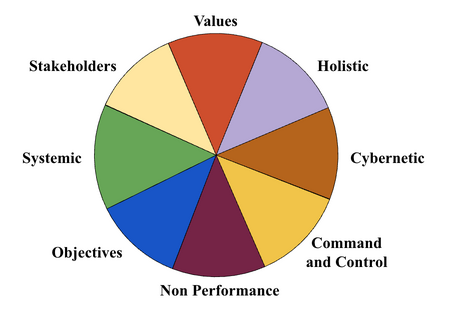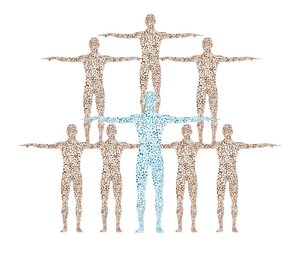Performance Models
Introduction
This article discusses different models of organizational performance that have been studied over the past decades and the trend toward a better understanding of how individuals function and perform in groups, which is essential for any other form of performance.
When accurately measured and condensed into results that can be applied across a wide range of topics related to a company’s strategy and daily operations, these measures provide a new foundation for raising organizational performance to new levels.
Performance Models
Organizational performance can be approached through various models, which address aspects of its measurement and control on the one hand, and its conceptualization on the other.
Until the 1980s, management control research had focused on performance measures within the cybernetic model, an extension of the more popular command-and-control model that had dominated until the 1950s. Considering new individual and cultural factors alongside non-financial measures has enabled the holistic model to gradually overcome some limitations of the cybernetic model[1]. Since the 2000s, thanks to capabilities from software platforms, the Internet, and later AI, Management Control System (MCS) packages have integrated and powered management control systems as an integral part of managing organizations, most often aligned with holistic models. The three grand models are summarized in this table and detailed in separate articles.
| Models | Focus |
|---|---|
| Command and Control | Traditional hierarchical top-down approach, with original management control systems for planning and controlling. |
| Cybernetic | Accounts for the first-order loop feedback, learning, and communication in addition to financial and production metrics. |
| Holisitc | Extends from the cybernetic model with the second-order feedback loop and emphasizes the relationships and interactions between the organization’s different parts, including its culture, vision, mission, and reward systems. |
Regarding its conceptualization, several approaches have been proposed for categorizing performance depending on the context: research, societal, leadership, organizational development, etc.. For example, the models can be grouped into three categories based on their origins in economics, organizational, and social research[2]. Others have suggested categorizing along the following three categories of objectives, systems, and stakeholders[3] which is the one we adopted here. The value model was analyzed separately from the stakeholders model because it offers a distinct general overall understanding of how individuals and organizations behave. The non-performance model was added, which stands apart and continues to be a powerful model for understanding and managing performance. This grouping enables highlighting different analytical anchor points, limitations, and relations with management control systems.
| Models | Focus |
|---|---|
| Objectives | Objectives are set and managed at different levels of the organization. Techniques such as cost-benefit analysis, management by objectives, individual criteria, or behavioral goals are used. |
| Systems | Systemic models emphasize the importance of an organization's means, such as inputs, outputs, resource acquisition, and processes. They include the operations research model, the structural contingency model, and the culturalist and social regulation models. |
| Stakeholders | Stakeholders' performance models emphasize the expectations of individuals and interest groups that are either within or surrounding the organization. It includes the organizational development model, satisfaction, and expectancy models. |
| Values | Value models extend from the stakeholder model to understand organizations based on individual values and preferences. The concept of values encompasses broad aspects of social behavior that, unlike others, can be described, measured, and shared. |
| Non-performance | It is easier, more precise, consensual, and beneficial to address performance issues by problems and faults rather than by skills and performance criteria. |
Organizational performance models have grown over the years, not to supplant previous models but rather to refine them, better understand their scope, and create new models that better fit their times. Since the 2000s, with the Internet, and more recently with AI, our capacity to collect and analyze people's data has grown to incredible levels, and so has the capacity of management control systems, and our potential to better understand and manage people. How organizations can better perform over time remains a question tied to how people can better perform individually and in teams.
Individual Performance: The Adaptive Profiles
As the conceptualization of organizational performance and management control systems has greatly progressed over the past decades, so has the understanding of people and their management. Although taking more time than in technology, research in social science has had the chance to build, break, challenge, and test the limits of many models and techniques. Adaptive profiles emerged from research in the 1950s in the USA and started to penetrate small and large organizations worldwide progressively.
Adaptive profiles measure people's social behavior and how they perform in context.
The profiles are obtained through an assessment technique that adds objectivity by applying statistical methods and removing important biases. The results are profiles that accurately depict, with nuance, how people behave, feel, and think about it. They also inform about people's adaptation and engagement, the conditions to avoid underperformance, and to maximize individual performance. At GRI, we have continued researching these profiles and taken their use to the organizational performance level[4].
Today, markets are familiar with behavioral trait and type assessments that have been extensively used in recruitment and coaching. Adaptive profiles, however, are more recent and based on factors rather than traits and types. They exhibit different characteristics from those of other techniques. They help to rethink and enhance individuals' private techniques. They bring precision and additional benefits to numerous applications in recruitment, management, leadership, and organizational development.
Measuring Organizational Performance
The adaptive profiles also apply to positions, teams, companies, and even at the industry and societal levels, representing the performance expected in jobs and in group-level activities.
Performance models based on values include a behavioral component, making them especially useful for practical applications and for management control systems. Behaviors are observable. We can discuss and analyze them more effectively than abstract concepts that are inferred from observations. We can measure them as we do with adaptive profiles. At the company level, those aspects increase the likelihood of reaching consensus on what those behaviors are and how to address them to improve performance.
For organizations, the information from the adaptive profiles can be regrouped and compared with that of position and group profiles to measure and analyze performance.[5].
Once a company's management has defined the behaviors expected in positions and teams, strategic indicators can formalize the intent and help manage performance gaps over time. Social indicators follow the adaptation and engagement of employees in the organization.[6]
Notes
- ↑ Henri, J. F. (2004). Performance measurement and Organizational Effectiveness: Bridging the gap. Managerial Finance. Vol. 30, No. 6, pp 93-123.
- ↑ Vibert C. (2004). Theories of macro organizational behavior: a handbook of ideas and explanations.
- ↑ Campbell, J. P. (1977). On the nature of Organizational effectiveness. In P. S. Godman & J. M. Pennings (Eds.), New perspectives on organizational effectiveness. San Francisco: Jossey-Bass. Pp. 13-55.
Zammuto, R. F. (1982). Assessing organizational effectiveness: Systems change, adaptation, and strategy. Albany, N.Y.:Suny-Albany Press.
Quinn, R. E., Rohrbaugh, J. (1983). A Spatial Model of Effectiveness Criteria: Towards a Competing Values Approach to Organizational Analysis. Management Science. Vol. 29, No. 3, pp. 363-377.
Cameron, K. S., Whetten, D. A. (1983). Organizational Effectiveness: One Model or Several? Preface. Orlando: Academic Press. - ↑ The adaptive profiles are discussed in detail in other articles such as this one here.
- ↑ See more information here on how adaptive profiles are used to operationalize performance at an individual level.
- ↑ See in this article, here, how strategic and social indicators are calculated based on the adaptive profiles.



